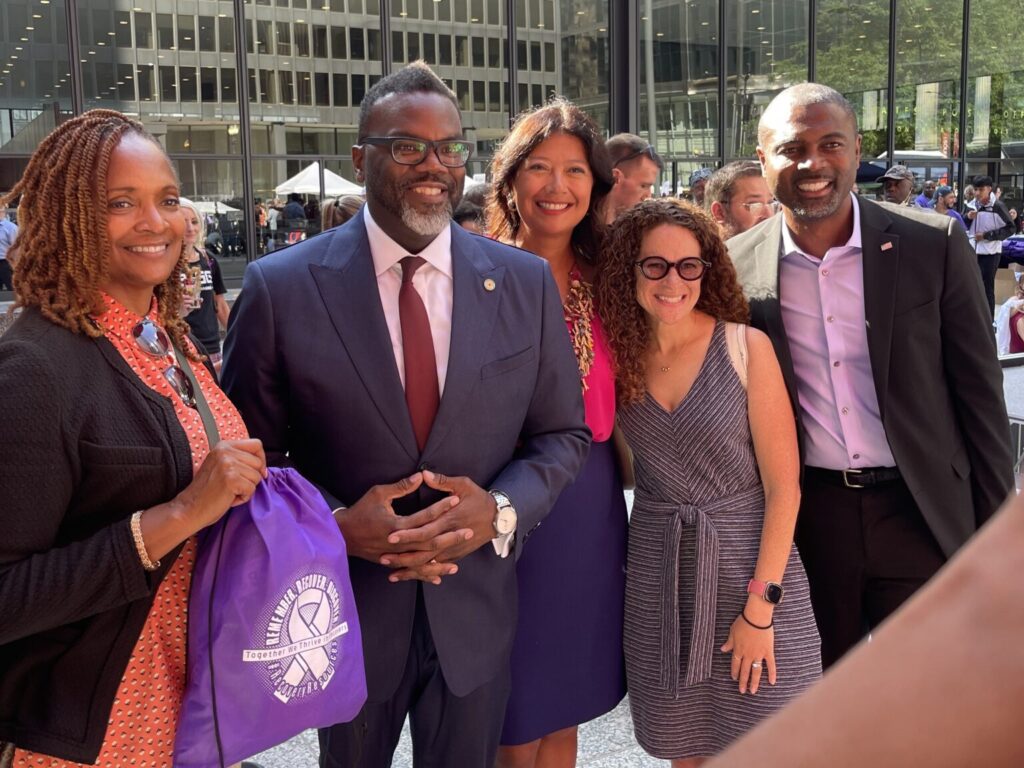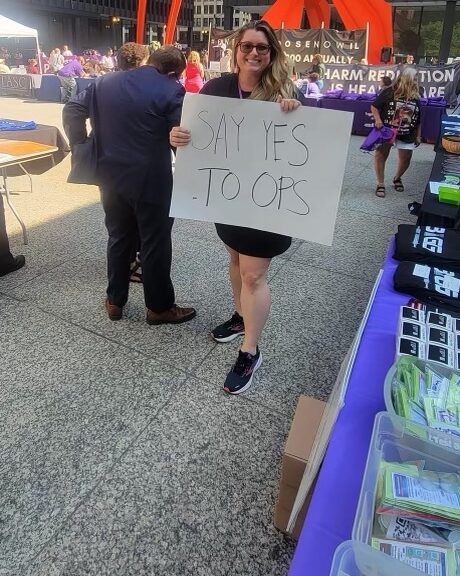On August 28, Chicago activists rallied at Federal Plaza in downtown Chicago, demanding that Illinois lawmakers take immediate action to prevent overdose deaths.
Illinois Harm Reduction & Recovery Coalition and 40 other community organizations were behind the event, which was timed for the week of International Overdose Awareness Day on August 31.
People who have lost loved ones to overdose addressed the rally, together with other advocates and officials including Chicago Mayor Brandon Johnson (D).
“We must not criminalize and further harm our brothers and sisters in need. We must create a real public health approach to this crisis,” Johnson said. “We will not incarcerate our way out of a crisis that stems from social and economic disparity and mental health struggles.”
The mayor spoke about losing his older brother. “He died addicted and unhoused. If only he would have had the services as well as the opportunity to experience treatment, not further trauma, I believe he would be alive today.”

Mayor Johnson addressed harm reduction activists and survivors.
The coalition is urging the state of Illinois to authorize safe consumption sites (SCS, also known as overdose prevention centers). Mayor Johnson is on record as stating, “I support these sites if it’s done in an equitable way.”
At SCS, people are able to use illicit drugs with trained staff, peers and overdose prevention resources on hand. The evidence is clear that SCS are effective in reducing overdose deaths, among other benefits, in communities where they’re located.
The Chicago rally also included a “resource fair,” where people received free naloxone, the opioid-overdose antidote, and other harm reduction supplies, plus the opportunity to speak with harm reduction and treatment providers.
International Overdose Awareness Day
The rally was held during a worldwide week of overdose awareness events. Held each year on August 31, International Overdose Awareness Day sees many groups around the world honor those who have lost their lives, while calling for political and community action.
In the United States alone this year, hundreds of community organizations and government agencies nationwide are holding memorials or other public actions.
Among many others, these include: a New York City march, vigil and rally to demand harm reduction, led by groups including OnPoint NYC and VOCAL-NY; events in five North Carolina counties, hosted by Students for Sensible Drug Policy’s Youth Overdose Prevention Fellows; a harm reduction giveaway in Milwaukee, Wisconsin, hosted by Samad’s House and the city Office of African American Affairs; free legal, education, housing and clothing resources offered by Community Street Team in Newark, New Jersey; and a vigil and cookout in Peoria, Illinois, hosted by Jolt Harm Reduction, Broken No More and Grief Recovery After a Substance Passing (GRASP).
Safe consumption sites are high on many organizations’ agendas. At least 200 SCS operate in at least 12 countries worldwide, and no overdose death has been recorded at any of them. Yet in the United States, which is suffering unprecedented numbers of overdose deaths, there are currently just two sanctioned SCS—both operated by OnPoint NYC in New York City, where they have so far averted over 1,000 overdoses.
Rhode Island was the first state government to authorize SCS, under a pilot program approved in 2021; its first center is finally expected to open in early 2024. Earlier this year, Minnesota became the second state to approve funding to develop SCS. Efforts to authorize the sites continue in many other states, despite the Biden administration’s opposition.
This battle, like those elsewhere, is literally life-or-death.
In Illinois earlier this year, harm reduction advocates championed a bill that would have authorized a pilot site in Chicago. But the bill failed to advance in the state legislature, with too few politicians willing to get behind it.
 Activists in Chicago demonstrated beside a mock overdose prevention site.
Activists in Chicago demonstrated beside a mock overdose prevention site.
When asked about these efforts, Johnson said, “This is something that I’ve talked about on the campaign trail, [it’s] all of us working together to come up with a viable solution, and this is one that’s been on the table. I’m looking forward to having those conversations.”
For now, House Bill 2 has been referred to the Rules Committee in the state Assembly. It could receive a vote during the General Assembly Veto Session in October.
This battle, like those elsewhere, is literally life-or-death. Illinois recorded an estimated 3,825 overdose deaths in 2022, according to CDC data. About three in four involved fentanyl, and fentanyl-related deaths have been rising since 2015. Deaths involving cocaine, and to a lesser extent methamphetamine, are reportedly also trending up each year.
Chicago’s West Side
Chicago is hit especially hard. Cook County, which includes the city and its suburbs, counted 2,000 opioid-involved overdose deaths in 2022, a record high. An overwhelming 91 percent involved fentanyl. These victims, primarily living in the city itself, were predominantly male and disproportionately Black. A 2020 city report showed that despite making up less than a third of Chicago’s population, Black residents suffered nearly 60 percent of the city’s overdose deaths, with the rate surging.
Within Chicago, one of the most impacted areas is the city’s West Side. In response, the West Side Heroin/Opioid Task Force has mobilized to provide harm reduction education and resources like naloxone to people most at risk, especially Black and Brown residents who face severe health disparities. A survey published in 2020 found that 86 percent of West Side residents would support an SCS opening in their community.
“If the overdose prevention site comes, we make sure the people who use the site who are Black and Brown have an atmosphere where people feel welcome, they won’t be turned away.”
“We go out to the places where people have overdosed,” Pastor Fanya Burford-Berry, associate director of the West Side Task Force, told Filter. “We teach Narcan to the community, across the street from drug dealers. We train people on it so they can see a reduction in overdoses.”
“West Side is about building trusted relationships,” she added. “We have to be out, be seen, remember stories, remember names. It is so important, I don’t think a lot of people who work in health care understand that. You have to show up; if you make a promise you have to commit to it.”
Burford-Berry hopes to see an SCS open in Chicago within the next year. But she wants to make sure that its design, staffing and policies are geared towards welcoming all people who use drugs—whether they inject, smoke or snort the substances they bring. It must be a place, she emphasized, that local people of color, particularly, feel comfortable returning to for support.
“That’s why we are engaged in this process,” she said. “If the overdose prevention site comes, we make sure the people who use the site who are Black and Brown [have an] atmosphere where people feel welcome, they won’t be turned away, we know their names and provide hospitality.”
Top photograph: “Ask Me About My Kid,” a demonstration by Angel Moms at the Chicago rally. All photographs by Laura Fry, used with permission courtesey of Chelsea Laliberte Barnes.





Show Comments